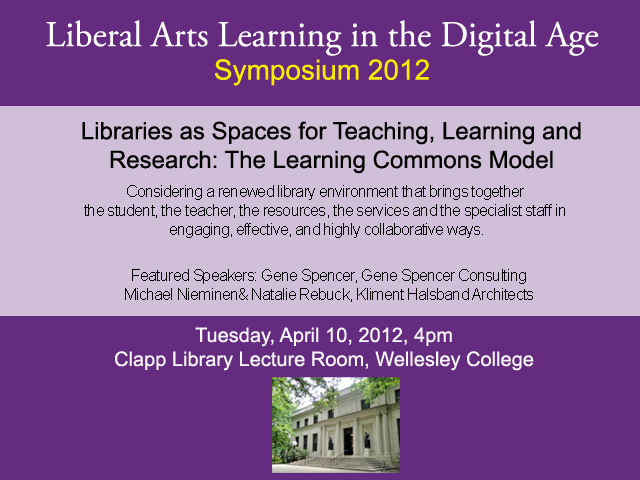http://www.youtube.com/watch?v=hLLXOQRv238
- 0:00:00 Event Introduction
- 0:00:48 Wellesley’s Library Spaces and the Learning Commons Model, Eileen Hardy and Heather Woods
- 0:06:00 Library Spaces, Michael Nieminen and Natalie Rebuck
- 0:28:06 Learning Commons, Gene Spencer
- 0:59:49 Q&A
Join the conversation by posting a comment or on Twitter using the hashtag #wellesleyLC
See the site about this event.
The library has been central to the learning process at Wellesley since its inception. The library’s collections and services have evolved over time as the curriculum, pedagogy and technologies have advanced, but serving as a learning center has always been central to its role. As we consider anew the factors driving change in higher education and scholarship we see a set of new learning and teaching spaces, located in a renewed library environment that brings together the student, the teacher, the resources, the services and the specialist staff in engaging, effective and highly collaborative ways.
What does the Wellesley Library look like in 2015 or in 2020?
A provocative conversation starter – A Wellesley Learning Commons
A Learning Commons can enable knowledge seeking, analysis, synthesis, and creation; integrate library, IT, and other academic support services; foster information, collaborative, creative, and social interactions; offer unique information and technology resources; and/or provide a variety of teaching and learning spaces.
On other campuses a Learning Commons may aim to satisfy one or more of these goals, but a common vision for these spaces is to provide integrated or collaborative services in support of research and scholarship. At Wellesley, this integration would recognize what the LTS staff reorganization (including the move of our division to the Provost’s office) has already responded to: the blurred line between information and technology, our connectedness to other academic support services across campus and our responsibility to allow for experimentation while rigorously testing cutting-edge information and technology solutions.
A Learning Commons at Wellesley might
- Honor the liberal arts by providing a central location for synergy among the disciplines and a space where crossing boundaries is encouraged and supported
- Integrate learning services on a single floor of Clapp Library (information, technology, tutoring, advising, first-year programming/support, others)
- Set these services in the embrace of specialized library collections and resources
- Include “campus-wide” spaces as well as specialized centers (a New Media Center) and unique resources
- Support the creation of discipline specific learning communities by rethinking the teaching and learning spaces in the branch libraries
- Foster risk taking, experimentation and rigorous investigation by providing a “cutting edge” emerging technology space
- Provide increased visibility of learning – elevating the draft process
- Establish Clapp Library as a “campus” building connected to the academic program and to campus life
Join us for a campus-wide conversation about the future of Wellesley’s library spaces and programming.

